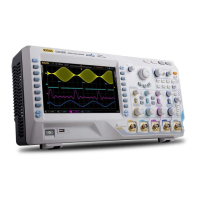Chapter 5 Trigger RIGOL
DS4000E User’s Guide 5-29
The default is “Normal”.
3. Specify the trigger condition
Press When and turn the multi-function knob to select the desired trigger
condition. You can also press When continuously to switch the current trigger
condition.
Start: trigger on the start of a frame.
Error: trigger when error frame is detected.
After this trigger condition is selected,
― press Stop Bit to select “1 bit” or “2 bit”.
― press Even-Odd and turn the multi-function knob to select “None”,
“Odd” or “Even”. You can also press Even-Odd continuously to switch
the current check type.
The oscilloscope determines error frames according to this setting.
Check Error: trigger when check error is detected.
When this trigger condition is selected,
― press Stop Bit to select “1 bit” or “2 bit”.
― press Even-Odd and turn the multi-function knob to select “Odd”
or “Even”. You can also press Even-Odd continuously to switch the
current check type.
The oscilloscope determines check error according to this setting.
Data: trigger on the last bit of the preset data bits and even-odd check bits.
When this trigger condition is selected,
― press Data Bits and turn the multi-function knob to select “5 bit”,
“6 bit”, “7 bit” or “8 bit”. You can also press Data Bits continuously to
switch the current data bits.
― press Data and turn the multi-function knob to select the desired
data.
The range of data is related to the “Data Bits” setting. When the data
bits is set to 5 bit, 6 bit, 7 bit and 8 bit, the ranges of data are 1 to 31,
0 to 63, 0 to 127 and 0 to 255 respectively.
― press Stop Bit to select “1 bit” or “2 bit”.
― press Even-Odd and turn the multi-function knob to select "None",
“Odd” or “Even”. You can also press Even-Odd continuously to switch
the current check type.
The oscilloscope will search for the specified data according to this setting.

